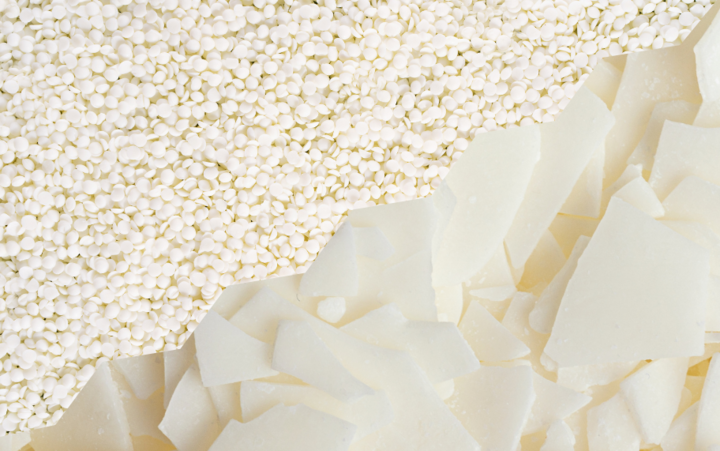Comparing Village Craft & Candle's Soy Waxes for Containers and Melts

A Comprehensive Guide to Village Craft & Candle's Soy Waxes for Containers and Melts
If you're in the market for soy wax, you may be overwhelmed by the options available. Soy wax is a popular choice for candles and wax melts because it is natural and renewable. In this article, we'll be exploring the different types of soy waxes that Village Craft & Candle offers for containers and melts, and we'll be examining how they perform under different temperatures and with dyes. We'll also be discussing the benefits of soy wax and why it's a great choice for candle-making.
What is Soy Wax?
First, let's define soy wax. Soy wax is a vegetable wax made from soybean oil. It's a natural and renewable resource, making it a more sustainable option than paraffin wax, which is a petroleum byproduct.
Soy wax also has a lower melting point than paraffin wax, which means that it burns at a cooler temperature and lasts longer. Additionally, soy wax is non-toxic and produces very little soot, making it a healthy and environmentally friendly option.
Now that we know the benefits of soy wax, let's take a closer look at the different types of soy waxes that Village Craft & Candle offers.
The Experiment
Erin Parsons, a representative from Village Craft & Candle, conducted an experiment to showcase the differences between each type of soy wax. She melted one pound of each wax to 180 degrees, then poured a candle with no scent or dye. After that, she added three drops of red dye to what was left of the pound and poured a melt at 175 degrees. Finally, she allowed the wax to cool as much as possible before pouring a final candle. It's worth noting that no fragrance was added during this particular test, so performance in that regard cannot be fully evaluated.
Here are the results for each wax:
Millennium Soy Wax
The first soy wax we examined was the Millennium soy wax. When poured at 180 degrees, this wax showed some signs of pulling away from the glass, resulting in wet spots and a slightly bumpy finish. When a melt was poured at the slightly lower temperature of 175 degrees, there was some frosting and a small crack down the middle. Upon cooling to 105 degrees and being poured again, wet spots appeared around the outside and some frosting was visible. Overall, the Millennium soy wax may require some extra attention and care to achieve the desired finish and performance you are looking for.
Coconut Soy Wax
Next up is the Freedom Coconut soy wax. When poured at 180 degrees, this wax showed some sinking around the wick and a slight crack, but had good glass adhesion and minimal pulling away from the glass. Some frosting was present, which is typical of soy wax. When a melt was poured at 175 degrees with three drops of dye, there was some frosting and the resulting colour leaned more towards pink than red due to the natural white colour of soy wax. Lastly, after cooling to 110 degrees and pouring again, the surface finish would have been smooth, however Erin remelted the wax that remained in the pour pot and added it to the top of the candle which caused some bumps and texture. Otherwise, there was no frosting around the outside and the glass adhesion was lovely. Overall, the wax performed well in terms of glass adhesion and only showed minor frosting.
Container Soy Wax
Erin was pleasantly surprised by the smooth and shiny finish of the Container Soy wax when poured at 180 degrees. While some frosting was present, the glass adhesion was decent. When a melt was poured at 175 degrees, there was less frosting than expected, but the resulting cold pour had a very bumpy and frosted finish.
Overall, this pure soy wax showed potential with a little room for improvement in the frosting and bumpy finish department. It's worth noting that Village Craft & Candle recommends not adding dye to this wax, as it looks better without any added colourant.
Freedom Soy Wax
Freedom Soy Wax is a popular choice among candle makers due to its beautiful, smooth tops and good glass adhesion. Poured at 180F, the candle had a nice smooth finish with little frosting. The melt poured at 175F had some frosting on both the front and back, but the finish is generally nice. The cold pour was a bit tricky, as by the time the wax was cooled to 105 degrees Fahrenheit, it was very cloudy and had begun to set around the sides of the pour pot. However, once cooled, the candle had very little frosting and good glass adhesion.
Overall, Freedom Soy Wax is a good choice for candle makers who want a smooth and glossy finish with good glass adhesion. It is recommended that you pour this wax at slightly hotter temperatures.
Golden Brand 464
Golden Brand 464 is a very similar soy wax blend to the Freedom soy. When poured at 180 degrees Fahrenheit it had a nice smooth finish and good glass adhesion. The dyed melt that was poured at 175 degrees Fahrenheit showed only slight signs of frosting and otherwise had a nice finish. The candle that was poured at a cooler temperature had a large crack all the way around the wick where the wax had sunk a bit, but other than that, there was little frosting and no wet spots.
Overall, like with Freedom, it is recommended that this wax be poured at warmer temperatures for best results.
Golden Brand 444
Golden Brand 444 is another soy wax that is worth considering if you are looking for a good quality wax for candle-making. The results showed that the wax produced a nice smooth finish with good glass adhesion. The top of the candle was smooth, and there was very little frosting when poured cold.
In terms of pouring temperature, when the wax was poured at 180 degrees Fahrenheit it performed well. There was some frosting on the melt, but not too much. The cold pour was done at 108 degrees Fahrenheit and produced a smooth finish with minimal frosting and good glass adhesion.
Overall, Golden Brand 444 appears to be a good quality soy wax option for candle-making, especially if you're looking for a wax that produces a smooth finish and good glass adhesion.
It is also ideal for hotter climates as it has a slightly hotter melt point than other soy wax blends.
Golden Brand 415
Golden Brand 415 is another pure soy wax like the Container soy. They don’t have the botanical additives found in other soy wax blends. This lack of additives can lead to inconsistencies in the wax. When poured hot, the wax resulted in bumps and craters, but the glass adhesion was not bad. This is where the botanical additives found in other soy wax blends come in to help smooth out the consistency.
During the melt test, there was frosting present, as expected for a pure soy wax, especially when it is dyed. The cold pour was done at 105 degrees, and there was still some frosting, and also noticeable wet spots.
Overall, the Golden Brand 415 is a good option for those looking for a pure soy wax, but it may require some extra attention to achieve a smooth finish and dying is not recommended.
Golden Brand 494
Golden Brand 494 is another soy wax option offered by Village Craft & Candle. This wax is slightly harder than the other soy wax blends and is made specifically for melts and tarts. This wax is not recommended for candles as the botanical additives used in it can clog wicks. It has a smooth and creamy texture whether it was poured at a hot temperature or a cooler temperature, making it ideal to work with. Since it is harder, it pops out of moulds easily and snaps apart without crumbling.
Overall, if you are looking for a beautiful wax that is easy to use for your melts and tarts, the Golden Brand 494 soy wax is an excellent choice for you.
NatureWax C3
NatureWax C3 is a soy wax that's highly favoured by candle-makers for its smooth and creamy texture. It produces a smooth and shiny finish with minimal frosting and excellent glass adhesion when poured at 180 degrees. When a melt was poured at 175 degrees with dye, there was some frosting present, but the resulting colour was beautiful. When the wax was cooled to 110 degrees and poured again, the finish was smooth and shiny with no frosting or wet spots. In addition to its excellent finish, NatureWax C3 also boasts of a great scent throw, making it a top choice for candle-makers.
Conclusion
In conclusion, Village Craft & Candle offers a variety of soy waxes that cater to different preferences and needs.
Soy wax is a natural and eco-friendly option with a low melting point, longer burn times, and few health and environmental concerns.
After conducting the experiment, it is clear that the "best" soy wax depends on your preferences and what you're looking for in a wax.
When choosing a soy wax, it's important to consider factors such as glass adhesion, frosting, and scent throw, as well as the desired finish and colour.
Some waxes are better suited for containers, while others are better for melts or pillars.
Some waxes have a smoother finish, while others may have more frosting but a great scent throw.
Consider the properties of each wax and how they will work with your specific project to make an informed decision. Experimenting with different types of soy wax can lead to discovering a favourite and perfecting the art of candle-making.





